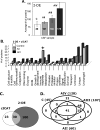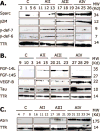Proteomic identification of biomarkers in the cerebrospinal fluid (CSF) of astrocytoma patients
- PMID: 17269713
- PMCID: PMC2566942
- DOI: 10.1021/pr060240z
Proteomic identification of biomarkers in the cerebrospinal fluid (CSF) of astrocytoma patients
Abstract
The monitoring of changes in the protein composition of the cerebrospinal fluid (CSF) can be used as a sensitive indicator of central nervous system (CNS) pathology, yet its systematic application to analysis of CNS neoplasia has been limited. There is a pressing need for both a better understanding of gliomagenesis and the development of reliable biomarkers of the disease. In this report, we used two proteomic techniques, two-dimensional gel electrophoresis (2-DE), and cleavable Isotope-Coded Affinity Tag (cICAT) to compare CSF proteomes to identify tumor- and grade-specific biomarkers in patients bearing brain tumors of differing histologies and grades. Retrospective analyses were performed on 60 samples derived from astrocytomas WHO grade II, III, and IV, schwannomas, metastastic brain tumors, inflammatory samples, and non-neoplastic controls. We identified 103 potential tumor-specific markers of which 20 were high-grade astrocytoma-specific. These investigations allowed us to identify a spectrum of signature proteins that could be used to distinguish CSF derived from control patients versus those with low- (AII) or high-grade (AIV) astrocytoma. These proteins may represent new diagnostic, prognostic, and disease follow-up markers when used alone or in combination. These candidate biomarkers may also have functional properties that play a critical role in the development and malignant progression of human astrocytomas, thus possibly representing novel therapeutic targets for this highly lethal disease.
Figures





Similar articles
-
Attractin is elevated in the cerebrospinal fluid of patients with malignant astrocytoma and mediates glioma cell migration.Clin Cancer Res. 2006 Nov 1;12(21):6331-6. doi: 10.1158/1078-0432.CCR-06-1296. Clin Cancer Res. 2006. PMID: 17085642
-
Proteomics of tumor-specific proteins in cerebrospinal fluid of patients with astrocytoma: usefulness of gelsolin protein.Pathol Int. 2009 Nov;59(11):797-803. doi: 10.1111/j.1440-1827.2009.02447.x. Pathol Int. 2009. PMID: 19883430
-
Cerebrospinal fluid (vascular endothelial growth factor) and serologic (recoverin) tumor markers for malignant glioma.Cancer Control. 2004 May-Jun;11(3):174-80. doi: 10.1177/107327480401100305. Cancer Control. 2004. PMID: 15153841 Clinical Trial.
-
[OMICS and biomarkers of glial tumors].Rev Neurol (Paris). 2011 Oct;167(10):691-8. doi: 10.1016/j.neurol.2011.07.007. Epub 2011 Sep 1. Rev Neurol (Paris). 2011. PMID: 21889780 Review. French.
-
Proteomic Biomarker Identification in Cerebrospinal Fluid for Leptomeningeal Metastases with Neurological Complications.Adv Exp Med Biol. 2017;974:85-96. doi: 10.1007/978-3-319-52479-5_5. Adv Exp Med Biol. 2017. PMID: 28353226 Review.
Cited by
-
Liquid biopsies in patients with diffuse glioma.Acta Neuropathol. 2015 Jun;129(6):849-65. doi: 10.1007/s00401-015-1399-y. Epub 2015 Feb 27. Acta Neuropathol. 2015. PMID: 25720744 Free PMC article.
-
Circulating glioma biomarkers.Neuro Oncol. 2015 Mar;17(3):343-60. doi: 10.1093/neuonc/nou207. Epub 2014 Sep 24. Neuro Oncol. 2015. PMID: 25253418 Free PMC article. Review.
-
Insights into pediatric diffuse intrinsic pontine glioma through proteomic analysis of cerebrospinal fluid.Neuro Oncol. 2012 May;14(5):547-60. doi: 10.1093/neuonc/nos067. Epub 2012 Apr 5. Neuro Oncol. 2012. PMID: 22492959 Free PMC article.
-
Proteome analysis of human cerebrospinal fluid as a diagnostic biomarker in patients with meningioma.Med Sci Monit. 2012 Nov;18(11):BR450-60. doi: 10.12659/msm.883538. Med Sci Monit. 2012. PMID: 23111736 Free PMC article.
-
Fibrinogen gamma-A chain precursor in CSF: a candidate biomarker for Alzheimer's disease.BMC Neurol. 2007 Jun 12;7:14. doi: 10.1186/1471-2377-7-14. BMC Neurol. 2007. PMID: 17565664 Free PMC article.
References
-
- Strickler R, Phillips ML. Astrocytomas: the clinical picture. Clin J Oncol Nurs. 2000;4:153–158. - PubMed
-
- Senger D, Cairncross JG, Forsyth PA. Long-term survivors of glioblastoma: statistical aberration or important unrecognized molecular subtype? Cancer J. 2003;9:214–221. - PubMed
-
- Wulfkuhle JD, Liotta LA, Petricoin EF. Proteomic applications for the early detection of cancer. Nat Rev Cancer. 2003;3:267–275. - PubMed
-
- Petricoin EF, 3rd, Bichsel VE, Calvert VS, Espina V, Winters M, Young L, Belluco C, Trock BJ, Lippman M, Fishman DA, Sgroi DC, Munson PJ, Esserman LJ, Liotta LA. Mapping molecular networks using proteomics: a vision for patient-tailored combination therapy. J Clin Oncol. 2005;23:3614–3621. - PubMed
-
- Liotta LA, Ferrari M, Petricoin E. Clinical proteomics: written in blood. Nature. 2003;425:905. - PubMed
Publication types
MeSH terms
Substances
Grants and funding
LinkOut - more resources
Full Text Sources
Other Literature Sources

